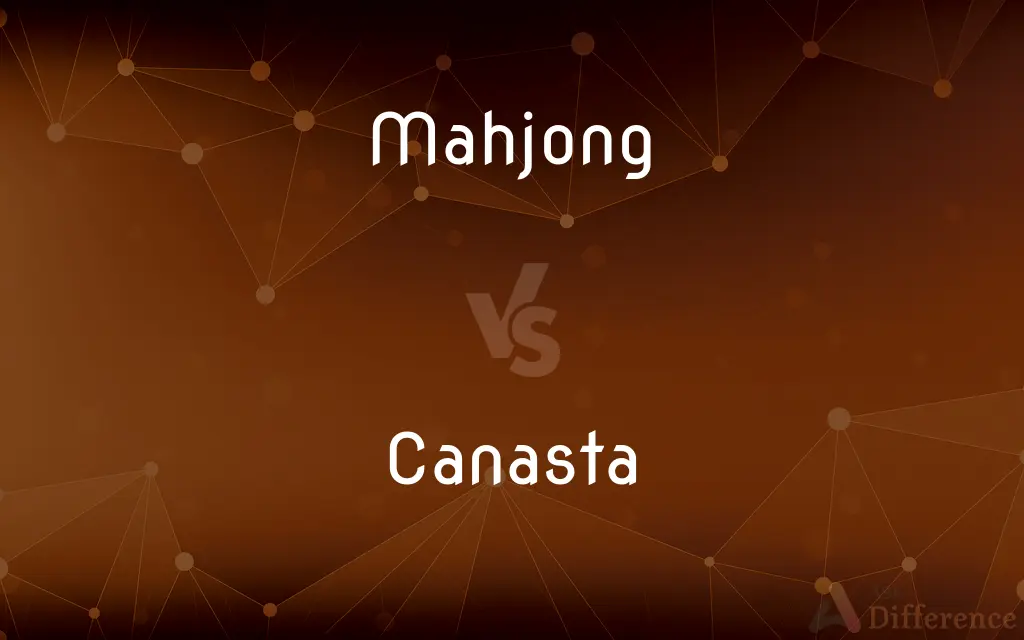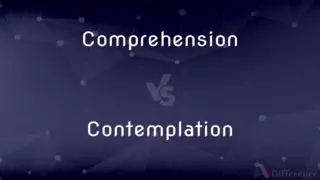Mahjong vs. Canasta — What's the Difference?
By Tayyaba Rehman & Maham Liaqat — Updated on April 15, 2024
Mahjong is a tile-based game originating from China, emphasizing strategy and calculation, while Canasta is a card game from Uruguay, focusing on melding cards for points.

Difference Between Mahjong and Canasta
Table of Contents
ADVERTISEMENT
Key Differences
Mahjong is traditionally played with a set of 144 tiles based on Chinese characters and symbols, where players draw and discard tiles to make a legal hand. Canasta, on the other hand, uses two standard decks of cards, including jokers, where players aim to make melds of seven cards of the same rank.
In Mahjong, the game is played by four people, making it a social yet competitive game. Whereas Canasta can be played by two to six players, often in partnerships, which adds a collaborative aspect to its gameplay.
Mahjong involves a significant degree of skill, strategy, and calculation, along with a degree of chance. Conversely, Canasta involves strategies related to hand management and the timing of melding, but is generally considered to have a larger element of luck compared to Mahjong.
Scoring in Mahjong can be complex, involving multiple factors like the types of melds made, bonus tiles, and even the version of the game being played. In contrast, scoring in Canasta is more straightforward, based primarily on the point values of the cards in melds and bonuses for certain achievements like going out.
Cultural significance also differs greatly; Mahjong has deep roots in Chinese culture and has been widely depicted in Chinese cinema and literature. Canasta, while popular in many countries, does not carry the same cultural weight but has a strong following in North America and other regions since its creation in the mid-20th century.
ADVERTISEMENT
Comparison Chart
Origin
China
Uruguay
Components
144 tiles with Chinese characters and symbols
Two standard decks of cards with jokers
Player Count
Typically 4
2 to 6 (commonly played in partnerships)
Gameplay Focus
Strategy, skill, calculation
Melding cards, hand management
Cultural Significance
Deeply embedded in Chinese culture
Popular in North America, less cultural weight
Compare with Definitions
Mahjong
Involves multiple scoring rules that reward different tile formations.
Scoring in Mahjong can be quite complex, involving various bonuses and penalties.
Canasta
A game where players use decks of cards to form melds.
They taught us how to play Canasta at the community center.
Mahjong
A game where players draw and discard tiles to form a legal hand.
We played Mahjong at her house last night, and I finally won!
Canasta
Focuses on creating melds of cards for scoring points.
In Canasta, melding seven cards of the same rank is a key strategy.
Mahjong
Emphasizes strategic thinking and planning.
Mahjong requires more than luck; you need to strategize effectively to win.
Canasta
Developed in Uruguay, and spread globally.
Canasta was originally a South American game before becoming popular worldwide.
Mahjong
Originated in China, reflecting its rich cultural heritage.
Mahjong is often featured in Chinese festivals due to its cultural significance.
Canasta
Scores are based on the values of the cards in melds.
Scoring in Canasta is simple, focusing mainly on the card values in melds.
Mahjong
Typically played by four players in a competitive setup.
Our Mahjong group meets weekly, rotating players each game.
Canasta
Can be played by varying numbers of players.
Canasta is versatile, accommodating anywhere from two to six players.
Mahjong
Mahjong or mah-jongg (English pronunciation: mah-JONG, Mandarin Chinese: [mǎ.tɕjâŋ]) is a tile-based game that was developed in the 19th century in China and has spread throughout the world since the early 20th century. It is commonly played by four players (with some three-player variations found in parts of China, Japan, South Korea and Southeast Asia).
Canasta
Canasta (; Spanish for "basket") is a card game of the rummy family of games believed to be a variant of 500 Rum. Although many variations exist for two, three, five or six players, it is most commonly played by four in two partnerships with two standard decks of cards.
Mahjong
A game of Chinese origin usually played by four persons with tiles resembling dominoes and bearing various designs, which are drawn and discarded until one player wins with a hand of four combinations of three tiles each and a pair of matching tiles.
Canasta
A card game for two to six players, requiring two or three decks of cards, in which the object is to obtain melds of three or more cards of the same rank.
Mahjong
A game (originally Chinese) for four players, using a collection of tiles divided into five or six suits.
Canasta
A meld of seven cards having the same rank in this game.
Mahjong
A solitaire game using the same tiles, where the player wins by removing pairs of matching exposed tiles until none remain.
Canasta
A card game similar to rummy and played using two packs, where the object is to meld groups of the same rank.
Mahjong
A Chinese game played by 4 people with 144 tiles.
Canasta
A meld of seven cards in a game of canasta.
Mahjong
Chinese game played by 4 people with 144 tiles
Canasta
A form of rummy using two decks and four jokers; jokers and deuces are wild; the object is to meld groups of seven of the same rank.
Canasta
A form of rummy using two decks and four jokers; jokers and deuces are wild; the object is to meld groups of seven of the same rank
Common Curiosities
What is the main objective in Mahjong?
The main objective in Mahjong is to be the first to form a complete hand of 14 tiles, which includes a pair and four melds.
What is a meld in Canasta?
A meld in Canasta is a set of at least three cards of the same rank, which can include wild cards.
Can Canasta be played in teams?
Yes, Canasta is often played in teams, especially in versions designed for four or six players.
How many tiles are used in Mahjong?
Mahjong uses 144 tiles, including character tiles, bamboo tiles, and circle tiles, among others.
How does scoring work in Canasta?
Scoring in Canasta involves adding up the point values of all melds and subtracting the values of unmelded cards.
What role do jokers play in Canasta?
Jokers in Canasta are wild cards that can be used to complete any meld.
What makes Mahjong challenging?
The complexity of the rules and the need for strategic planning make Mahjong challenging.
How long does a typical game of Mahjong last?
A typical game of Mahjong can last about two to four hours, depending on the version and players' skill levels.
What is the best strategy for beginners in Canasta?
Beginners should focus on understanding the rules of melding and the strategic use of wild cards.
What are the key skills needed to win at Mahjong?
Key skills include strategic thinking, quick decision-making, and a good memory.
Is Canasta suitable for children?
Yes, Canasta can be a fun and suitable game for children, especially as a way to teach counting and strategy.
What types of melds are most valuable in Canasta?
Melds of sevens, known as 'canastas', are particularly valuable in Canasta.
Can Mahjong be played competitively?
Yes, Mahjong is played competitively, including in tournaments worldwide.
Is there a version of Mahjong for fewer players?
Yes, there are variations of Mahjong that can accommodate fewer than four players.
Does Mahjong require special equipment?
Yes, Mahjong typically requires a set of tiles and often a table specifically designed for the game.
Share Your Discovery

Previous Comparison
Comprehension vs. Contemplation
Next Comparison
Pot vs. VatAuthor Spotlight
Written by
Tayyaba RehmanTayyaba Rehman is a distinguished writer, currently serving as a primary contributor to askdifference.com. As a researcher in semantics and etymology, Tayyaba's passion for the complexity of languages and their distinctions has found a perfect home on the platform. Tayyaba delves into the intricacies of language, distinguishing between commonly confused words and phrases, thereby providing clarity for readers worldwide.
Co-written by
Maham Liaqat















































